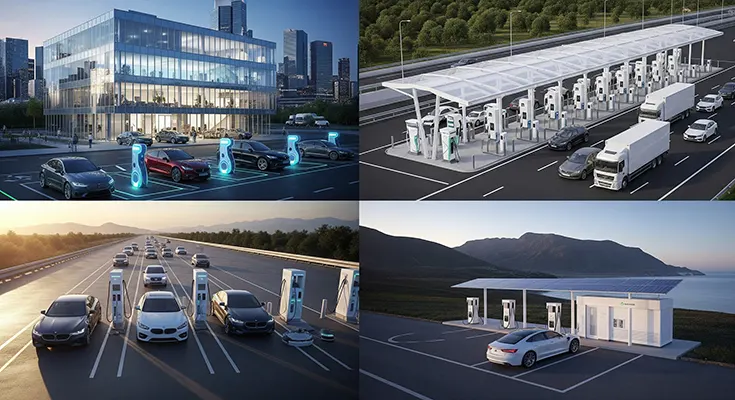As electric vehicle (EV) sales continue their exponential climb, the global focus is shifting from a simple question of “if” EVs will succeed to a more complex one: “how” will we power them? The development of a robust, accessible, and intelligent charging infrastructure is the lynchpin of the EV revolution. Around the world, a series of critical trends are shaping this vital ecosystem.
1. The Rise of Fast Charging: The Race for Speed
The most significant trend in public charging is the rapid deployment of high-power DC fast chargers. While Level 2 chargers are sufficient for home or overnight charging, the need for quick top-ups on highways and in urban hubs is paramount for long-distance travel and daily convenience.
- Higher Power Output: The new standard is increasingly moving beyond 50 kW to ultra-fast chargers delivering 150 kW, 250 kW, and even 350+ kW. These chargers can add hundreds of miles of range in just 15-30 minutes, drastically reducing “refueling” time and directly addressing a key driver of consumer range anxiety.
- Strategic Deployment: Fast chargers are being strategically placed along major transportation corridors, at retail locations, and in dedicated charging hubs to minimize driver downtime and enable cross-country trips.
2. Government and Private Sector Collaboration
The scale of investment required to build out a comprehensive charging network is immense, necessitating strong public-private partnerships. Governments are playing a pivotal role through various mechanisms:
- Subsidies and Incentives: Tax credits, grants, and subsidies for both charger installation and EV purchases are accelerating development. The U.S. National Electric Vehicle Infrastructure (NEVI) Formula Program and similar initiatives in Europe and Asia are channeling billions of dollars into building a cohesive network.
- Regulatory Support: Governments are setting targets for the number of charging points, standardizing charging protocols (e.g., the push for CCS as a universal standard), and mandating the inclusion of charging infrastructure in new building codes and parking regulations.
- Public-Private Partnerships: Cities and states are leasing public land to private companies, or partnering with them to install and operate charging stations, leveraging private capital and expertise to accelerate the rollout.
3. Smarter Charging for a Smarter Grid
EV charging is no longer just a simple transfer of electricity. The integration of smart technology is transforming charging into an intelligent, grid-friendly process.
- Smart Charging and Load Management: Smart charging systems can communicate with the grid to optimize energy use, scheduling charging for off-peak hours when electricity is cheaper and demand is lower. This helps to reduce the strain on the electrical grid and can lower charging costs for consumers.
- Vehicle-to-Grid (V2G) Technology: This is a game-changing innovation that allows EVs to not only draw power from the grid but also feed it back when needed. V2G technology can turn a fleet of EVs into a massive distributed energy storage system, helping to balance the grid, integrate more renewable energy, and even provide backup power for homes and businesses.
4. Diversification of Charging Models
Beyond the traditional public charging station, new models are emerging to meet diverse consumer needs and address unique challenges:
- Residential and Workplace Charging: Home and workplace charging remain the foundation of the EV ecosystem, accounting for a large portion of charging events. The trend here is toward smarter Level 2 chargers that can be managed remotely and integrated with utility rate plans.
- Curbside and Lamppost Charging: For urban dwellers without access to a garage or dedicated parking, innovative solutions like lamppost chargers and pop-up pavement chargers are a game changer. These solutions leverage existing street infrastructure to provide convenient and low-cost charging.
- Fleet-Specific Infrastructure: The electrification of commercial fleets (buses, trucks, delivery vans) is driving the development of high-capacity depot charging and “megachargers” designed to power heavy-duty vehicles, creating a distinct and rapidly growing market segment.
- Wireless Charging: While still in its early stages, wireless or inductive charging is a long-term trend. It promises a future where vehicles can charge automatically by simply parking over a charging pad, potentially leading to dynamic charging on electrified roads.
The global EV charging infrastructure is in a period of unprecedented expansion and innovation. The landscape is being shaped by a synergistic mix of technological advancements, supportive government policies, and a growing ecosystem of private companies. As the network becomes denser, faster, and smarter, it will not only meet the demands of a growing EV fleet but also become an integral part of a more sustainable and resilient energy grid. While regional disparities remain, the worldwide push to build a reliable charging backbone is undeniable, paving the way for a fully electric future.

